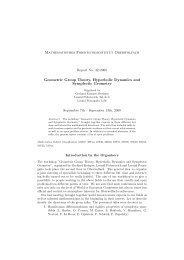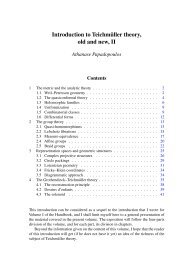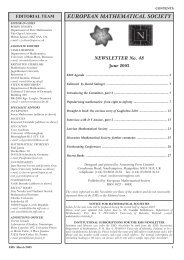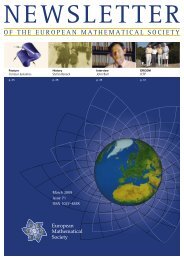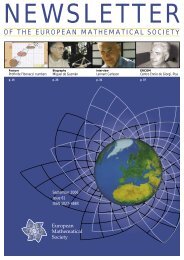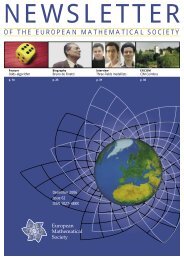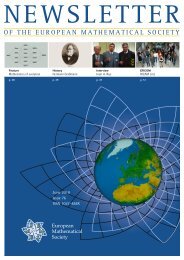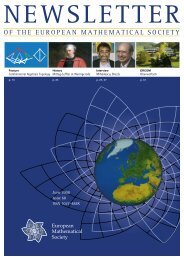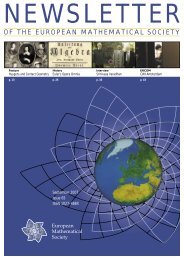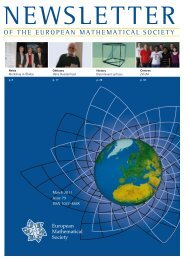March - European Mathematical Society Publishing House
March - European Mathematical Society Publishing House
March - European Mathematical Society Publishing House
Create successful ePaper yourself
Turn your PDF publications into a flip-book with our unique Google optimized e-Paper software.
Reproduction of a printed index card<br />
Three main mathematical domains were<br />
distinguished in the classification of the<br />
index: mathematical analysis, geometry<br />
and applied mathematics. Within these<br />
domains, several classes were identified<br />
and designated by a capital letter (see the<br />
table below). For instance, class A contained<br />
works devoted to elementary algebra,<br />
theory of algebraic and transcendent<br />
equations, Galois groups, rational fractions<br />
and interpolation. Each class (A to X) was<br />
generally divided into subclasses, divisions,<br />
sections and subsections: for instance, the<br />
code L14cá was used to designate the class<br />
of conics and surfaces of second degree<br />
(L), the subclass of conics (1), the division<br />
corresponding to tangents (4), the section<br />
dealing with tangents satisfying specific<br />
conditions (c) and the subsection corresponding<br />
to the case of right angles (á).<br />
<strong>Mathematical</strong> domain Classes<br />
<strong>Mathematical</strong> analysis A-J<br />
Geometry K-Q<br />
Applied mathematics R-X<br />
Repartition of the classes in each<br />
mathematical domain<br />
The repertoire was published from 1894<br />
until 1912, during which 20 series of 100<br />
index cards were published. Each series<br />
contained about 1000 bibliographical references,<br />
and thus these series represent a<br />
list of 20,000 mathematical works. More<br />
precisely, we can distinguish three<br />
moments in the publication of the series;<br />
they correspond to the three attempts to<br />
cover the whole classification, as shown in<br />
the following table:<br />
Period Number of Covered<br />
series published classes<br />
1894-1895 3 A1-X7<br />
1896-1905 12 A1-V9<br />
1906-1912 5 B12-X8<br />
The three periods of publication<br />
Is the mathematical repertoire a new tool<br />
for historians of mathematics?<br />
The intention of the SMF was to create a<br />
bibliographical tool for scholars in mathematics.<br />
Some journals adopted the classification<br />
of the index (for instance, the<br />
Bulletin de la Société Mathématique de<br />
France), but it is quite difficult to determine<br />
whether the mathematical community<br />
really used it. We are in possession<br />
of various documents concerning the creation<br />
and the publication of this bibliography,<br />
but there remain many points<br />
about which our information is still fragmentary.<br />
How many copies did the commission<br />
permanente print and sell? Was the<br />
bibliography largely distributed outside<br />
France? Why is it so difficult to find<br />
copies of the index cards in French or<br />
foreign libraries? (As far as we know, it is<br />
impossible to find a complete set of the<br />
20 series of the repertoire in any library<br />
in France, even in the Bibliothèque<br />
Nationale de France: we had the opportunity<br />
to work on a complete set thanks to<br />
Jean-Luc Verley.)<br />
There are some further questions concerning<br />
the general context of its creation:<br />
it would be useful to determine the<br />
relationships between this project and the<br />
universalistic and internationalist trends<br />
at the turn of the nineteenth century.<br />
The mathematical repertoire constitutes<br />
a modest project, compared to similar<br />
attempts in Germany, Belgium and Great<br />
Britain: there were three major challengers:<br />
• The mathematical bibliography compiled by<br />
Hermann Georg Valentin. Valentin was a<br />
chief librarian at the Berlin Library and<br />
he started the compilation of a mathematical<br />
bibliography in 1885, at the<br />
same time as the SMF. His aim was to<br />
collect all mathematical publications since<br />
the invention of typography. After several<br />
years of strained relations with the representatives<br />
of the French bibliography,<br />
Valentin finally became a member<br />
of the permanent commission (see<br />
[Eneström 1911], [Valentin 1885, 1900,<br />
1910]). His bibliography was probably<br />
never published, partly because of the<br />
First World War.<br />
• The Universal Bibliographical Repertoire.<br />
The Belgians Paul Otlet and Henri<br />
Lafontaine created this repertoire<br />
around 1895. It was conceived as a universal<br />
bibliography of human thought,<br />
and had some success for some years,<br />
but French mathematicians had some<br />
serious reservations.<br />
• The International Catalogue of Scientific<br />
Literature. The London Royal <strong>Society</strong><br />
created this project in the 1890s. Its<br />
aim was to publish, at an international<br />
level, regular bibliographies on every<br />
field of scientific research. Although<br />
the French scientific community was<br />
involved in this project, professional<br />
mathematicians (especially in France)<br />
also expressed strong reservations (see<br />
[Rasmussen 1995]).<br />
From a scientific point of view, the mathematical<br />
repertoire raises the problem of<br />
the internal structure of nineteenth-cen-<br />
FEATURE<br />
tury mathematics. At first glance, this<br />
bibliography can constitute an interesting<br />
tool for the study of mathematical production<br />
over a large period: its 20,000<br />
bibliographical references constitute a<br />
valuable source of investigation for historians<br />
of mathematics. However, this is<br />
probably not the main point. Indeed,<br />
with its specific and complex classification,<br />
the mathematical repertoire gives<br />
an outline of a specific conception of<br />
mathematics. It gives access to mathematics,<br />
and also to the conception of<br />
mathematics constructed by the mathematical<br />
community at that time. Does it<br />
give an adequate description of nineteenth-century<br />
mathematics? In the light<br />
of recent works in history of science,<br />
should its classification be considered as<br />
conservative or modern? Did the classification<br />
really take into account all the<br />
existing mathematical domains of nineteenth-century<br />
mathematics? Did the<br />
classification contain gaps, and if so, what<br />
were they?<br />
The creators of the project didn’t only<br />
propose a thematic ordering of mathematical<br />
fields; they also elaborated a personal<br />
definition of the mathematical corpus<br />
that the repertoire should take into<br />
account. They were, for instance, convinced<br />
that most of the works concerning<br />
pure and applied mathematics published<br />
since 1800 would be of interest for scholars.<br />
On the other hand, they excluded<br />
classical works that didn’t contain general<br />
results, notably those intended for students<br />
and for the preparation of examinations.<br />
In a similar way, they decided<br />
that works in applied mathematics would<br />
be mentioned only when they implied<br />
progress in pure mathematics. The introduction<br />
of such a separation between<br />
pure and applied mathematics is quite<br />
astonishing, particularly in the context of<br />
the development of engineer training in<br />
all <strong>European</strong> countries.<br />
What can historians of mathematics<br />
learn from such a bibliographical endeavour?<br />
In order to study precisely the structure<br />
of the catalogue, we created a computer<br />
database. Although we are a long<br />
way from the end of the data entry<br />
process, we can give an overview of the<br />
information that may be extracted from<br />
such a database. Our database currently<br />
contains 3692 bibliographical items, corresponding<br />
to the first four series of the<br />
repertoire (400 index files out of 2000).<br />
It is accessible on-line, thanks to Laurent<br />
Guillopé at the Cellule MathDoc:<br />
http://math-sahel. ujf-grenoble.fr/RBSM/.<br />
A general investigation covering 1700<br />
index files (17 series) provides information<br />
concerning the repartition of bibliographical<br />
references within the three<br />
main mathematical domains: mathematical<br />
analysis (A to J) represents 50% of the<br />
references, applied mathematics (R to X)<br />
33%, and geometry (K to Q) 17%. For<br />
mathematical analysis, the most important<br />
classes are those devoted to algebra<br />
(A), theory of functions (D), differential<br />
equations (H) and arithmetic (I). For<br />
applied mathematics, one can distinguish<br />
EMS <strong>March</strong> 2003 11




